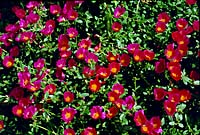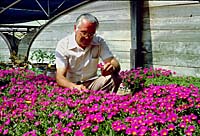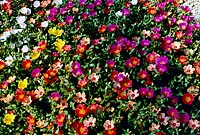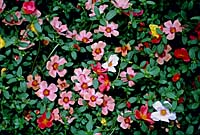
1.Big Blooming Purslane -- Big, Beautiful and Edible -- Dolly Parton's Pride

Purslane is eaten extensively in soups and salads throughout the Mediterranean area, where the incidence of heart disease is low. The Russians dry and can it for the winter. In Mexico it is called VERDOLAGA and is a favorite comfort food, eaten in an omelet or as a side dish, rolled in tortillas, or dropped by handfuls into soups and stews.
The exciting new health discovery is purslane's high content of alpha linolenic acid, a type of the omega-3 fatty acids. It may affect human health directly, but the most intriguing possibility is that the human body might be able to convert into other, related kinds of omega-3 fatty acids (EPA and DHA) found in fish oils. Researchers see evidence that these substances lower blood pressure and cholesterol levels as well as make the blood less likely to form clots. But ages before this scientific finding, purslane was eaten as treatment for arthritis, inflammation and heart disease and to promote general good health.
PURSLANE
Portulaca oleracea
Purslane FamilyPurslane is a succulent low-growing plant which is very tasty and crunchy. The entire plant can be used, the stems being most succulent. Purslane grows all over the world, often in disturbed soil. Purslane can be used as the main salad ingredient, lightly seasoned with diced onion, vinegar, and oil. The plant is good cooked with soups, steamed, sauteed, or pickled. Add it to omelets.
Thoreau used and enjoyed purslane, and he wrote of the plant, "I have made a satisfactory dinner off a dish of purslane which I gathered and boiled. Yet men have come to such a pass that they frequently starve, not from want of necessaries, but for want of luxuries."
IDENTIFYING PURSLANE
Purslane sprawls along the ground with its fleshy, succulent, highly branched stems. The stems are round and tinted red. The flavor of the raw stems is mild, slightly sour, and the texture is crunchy. The leaves are paddle-shaped (obovate), flat, and alternately arranged. The small flowers are yellow,sessile, and contain five two-lobbed petals. The small seed capsules produce abundant black seeds.
| Return to Index | Go to May - June |


